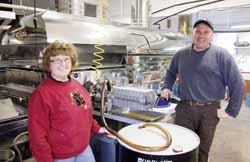
It Has Been an Unusual Year for Mapling
Maple sapping season started early across the northwoods and it may be lingering late.
Producers of nature’s sweetest treat started tapping trees in mid-February, weeks earlier than usual, and the up and down temperatures of March have turned the spigots on and off since.
‘It’s been an unusual year, Jim Adamski of Adamski’s Sugarbush, one of the area’s largest producers, said. Normally we don’t cook at all in February and this year we had 30 percent of our harvest done last month.
Maple sap is collected in the early spring, when temperatures get below freezing at night and above freezing during the day. The mid-February start compares to 2016’s average opening date for the season of March 6, according to U.S. Department of Agriculture statistics. And that was more than three weeks earlier than the March 28 season opener in 2014.
Adamski said that the early start worked fine for large-scale operators—those who connect lines to the trees and use vacuum pumps to extract the sap. Smaller producers—those who use bags or pails and lots of manual labor in the woods—got started weeks later, with some just hitting the woods now after waiting for the up and down forecast to stabilize.
At Crestwood Elementary School, volunteer Butch Duchac spent the last few weeks working with fourth graders on tapping maple trees, collecting the sap, and producing the syrup. Last week he was joined by Nick Salm and Mike Marozi who brought in waffle irons and batter for what has turned into an all-school waffles and syrup feed.
Adamski said the up-and-down nature of this season has had some benefits. The February sap had a lower-than-usual sugar content of 1.4 to 1.5, meaning more raw sap was needed to produce a gallon of syrup.
After the return to winter earlier this month, the sap’s sugar content has improved to over 2.0, he said.
The easiest way to explain it is the tree sap is like antifreeze, Adamski said. When it got cold, the trees produced more sugar in the sap in order to stay warm.
Just like gardeners and potato growers, maple syrup producers pay close attention to the weather, and after a few chilly, damp and dreary days ahead, the forecast for later in the weekend and into next week is improving.
We’re on track for an average crop if the weather holds, Adamski said. We’ve got about 40 percent of our harvest made as of today and we’re usually cooking well into April.
Sap collection can continue until the maple trees begin to bud.
Wisconsin is the nation’s fourth-leading producer of maple syrup, according to the USDA. The Badger State trails Vermont, which produced nearly 50 percent of the nation’s supply in 2016, New York and Maine in production.
A few maple facts:
—Pure maple syrup is only made on a commercial scale in North America – nowhere else in world.
—Maple syrup is generally produced in the states and provinces that surround the Great Lakes and the St. Lawrence River to the Atlantic Ocean.
—It takes approximately 40 gallons of maple sap from the trees to make one gallon of pure maple syrup, with the actual total depending on sugar content of the sap.
—Nothing is added to the sap, only water is evaporated away, to make pure maple syrup.
—Once concentrated to the correct density, pure maple syrup is filtered and hot pack- bottled.
—A tree large enough to tap can be re-tapped year after year, although a new tap hole must be drilled each season.
—Each tap can yield up to 10-plus gallons of sap per season on a gravity system, resulting in approximately one quart of finished syrup. Vacuum collection systems will yield approximately twice the sap of a gravity system.
—Pure maple syrup is a great natural food. It contains no preservatives, colorings or other additives.
—A gallon of maple syrup weighs 11 pounds compared to 8 pounds for a gallon of water.

Vicky and Jim Adamski with the natural gas-fired evaporator at Adamski’s Sugarbush southwest of Antigo.
Source: Antigo Daily Journal
